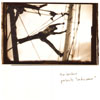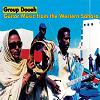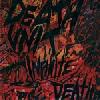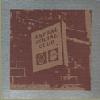- Matthew Amundsen
- Albums and Singles
 Hot on the heels of their highly praised full-length, Deerhunter drops this new set of stunning pop songs. Concise and catchy, these four tracks reveal remarkable development from their previous outing, further strengthening their growing reputation.
Hot on the heels of their highly praised full-length, Deerhunter drops this new set of stunning pop songs. Concise and catchy, these four tracks reveal remarkable development from their previous outing, further strengthening their growing reputation.
Foregoing some of the atmospherics of Cryptograms, the band opts instead for a more stripped-down approach on much of this material. They still launch into some of the explosions that made that album so memorable, but here these sections are tempered with a bit of restraint.
The title track begins with a piano, and then a guitar takes up the melody. With doubled vocals repeating the phrase "patiently, patiently," the song builds to a haunting finale. Organ, drums, and bass drive "Dr. Glass," the mellow pace a nice contrast to the lyrics depicting useless bodies, both living and dead. Similarly, the dreamy bliss of "Like New" masks references to skeletons and the crypt, suggesting darkness beneath the surface of everyday lives. The only song that sounds like it could have come from the full-length is "Wash Off," which channels the high-octane impulses of that album into an ode to the days of being 16. It's an exciting finale to a set that's over all too soon. As a bonus, a mesmeric video for "Strange Lights" is included on the disc.
While still retaining the aspects that made their previous songs so enjoyable, here the group pushes out in new directions equally as captivating, and in the process highlights ever more facets of their accomplished songwriting.
Read More
- Administrator
- Albums and Singles
 I love music that forms images in my mind because the transformation from one medium to the next seems so mysterious to me. That a musician can turn sound into the most vivid photograph ever without defaulting to the ease of field recordings seems a metaphysical conundrum, but some are quite good at it and others are veritable masters of the process. Tim Hecker may be the finest sonic photographer around, the rerelease of Radio Amor being further evidence for this claim.
I love music that forms images in my mind because the transformation from one medium to the next seems so mysterious to me. That a musician can turn sound into the most vivid photograph ever without defaulting to the ease of field recordings seems a metaphysical conundrum, but some are quite good at it and others are veritable masters of the process. Tim Hecker may be the finest sonic photographer around, the rerelease of Radio Amor being further evidence for this claim.
Alien8
Mille Plateaux released Radio Amor in 2002 amid a string of other Hecker recordings. It was not his only 2002 release, but some well-read publications gave it special attention and recognized Hecker's unique approach to sound and music. That recognition led to Radio Amor becoming mostly unavailable, out of print since some time in 2005. Hecker undoubtedly has a larger audience now. His music is becoming more pervasive and more people are looking back from Harmony in Ultraviolet and wondering where all this music came from. The best place to look would be on this album thankfully made available again by Alien8. Hecker's effortless, soporific mannerisms are in tact on Radio Amor but perhaps less refined, still in incubation and developing. Typically such a fact might be taken to speak poorly for a record, as though Mirages and Harmony in Ultraviolet are superior records because they exhibit a more sophisticated attention to detail or highlight a progression from earlier material. Hecker has been making music for a long time, however, and I think his continued growth speaks volumes about his art. Radio Amor may seem more simple, but its emotive depth does not suffer for that fact and, in addition, the chance to hear Hecker playing with more concrete melodies and structures is a lot of fun.
Evidently Radio Amor was composed with the work of a fishing vessel in mind, the body of a man moving about in the rigging and going about his work for the day. I'll have to admit that this was not the first image that came to mind when listening to these songs. I did, however, imagine floating in the air and finding myself lost among the clouds. Hecker's music is so strongly photographic that I have a difficult time describing it in any terms other than visual ones. When the music stutters near the end of "Spectral," I can only think of lightning radiating over the surface of the globe and as "I'm Transmitting Tonight" begins, a sudden plunge into the ocean seems inescapable, the slow motion of traveling underwater the firmest description I can proffer. Objectively, the music on Radio Amor is more concrete, there is a definite sharpness to these songs that I don't feel on Harmony in Ultraviolet and that Mirages had only fleetingly. The sounds move in well-defined blocks, heavy on the ears at times and distinct in memory. It's quite clear that each fragment of sound represents a frame or small series of frames from a much larger movie. When "7000 Miles" plays and the sound of wind and singing sand begins it's as though the entire visual project is being smeared about with impressionistic strokes: it is a stunningly fluid piece on a record that feels tightly structured and constructed from very solid, almost recognizable instruments.
The whole thing ends rather suddenly, but that may have more to do with Hecker's hypnotic powers than with any flaw on the record. After being drawn into the music's warm center, the sudden ejection from that place seems a little cruel and unexpected. "Trade Winds, White Heat," the album's closing piece, is an especially calm and extended moment, a loud and layered mass of easy drone pitched back and forth melodically, the fuzz of a radio signaling its final moments. With the transmission ended the room seems far quieter, tiny sounds are more obvious, and the simple joy of being temporarily motionless hangs in the air.
Samples can be found here.
Read More
- Scott Mckeating
- Albums and Singles
It's probably just as well I wasn't looking for two sides of music from Romero's new project with Shannon Walter, as one side of the disc is a field recording taken from a camping trip. It definitely works on a few levels though, sounding idyllic enough to make me want to get out there in the wide open blue. With birds tweeting happily and the running of distant water, I can at least close the curtains pretend and I'm out there.
The other track is more familiar Romero territory, a dark mire of sinking tones that float down against the notes of other rising lines. It's enjoyably ponderous, rumbling back and forth for the duration of the vinyl. Both disparate cuts are agreeable, but it might've been more interesting to hear a mash-up of both sides.
Read More
- Administrator
- Albums and Singles
Read More
- Administrator
- Albums and Singles
Tarentel's predominantly instrumental compositions read like chapters of an epic novel – vast and absolutely breathtaking. Tarentel's tidal force and blissful elegance elicit the kind of ecstatic response their name suggests. This album is being released as a series of 4 limited 12" LPs, each between 30 and 40 minutes...The series of 4 LPs comprised of studio and home recordings from September '04 to April '05, Ghetto Beats On The Surface Of The Sun isn't your grandma's Tarentel. It will eat your face, make you shake your ass - ass-shaking trashcan style, but with a healthy dose of psychedelic fever and blast off moon landing thrown in for good measure. Take your medicine!
Read More
- Administrator
- Albums and Singles
 This debut from Doueh and his group is outstanding. His playing is electric in all senses of the word; he effortlessly channels all the power of a sandstorm onto the six strings of his guitar. The recording quality may be patchy but the power of the music still comes through strong. The celebratory nature of the music combined with the skill of the players make this vinyl only release a joy to listen to.
This debut from Doueh and his group is outstanding. His playing is electric in all senses of the word; he effortlessly channels all the power of a sandstorm onto the six strings of his guitar. The recording quality may be patchy but the power of the music still comes through strong. The celebratory nature of the music combined with the skill of the players make this vinyl only release a joy to listen to.
Sublime Frequencies
On the first side of Guitar Music from the Western Sahara, some of the recordings are very tinny sounding, especially the first two songs which are a touch too grating on the ears to fully enjoy. This takes away from Doueh's exceptional gutiar playing on songs like "Eid El Arsh," which is completely obliterated from the recording when the chorus of vocals begin singing. Later on, the recordings become much cleaner and Doueh’s playing is given the space it deserves. Being home recordings they are still a little rough but more than acceptable.
A big deal is made in the sleeve notes about the influence of James Brown and Jimi Hendrix on Doueh and while the influence is sometimes audible, this description doesn't do Doueh's playing justice. He is, as one would expect, far more influenced by the immediate culture around him and though he assimilates some western influences into his playing, the music here is firmly rooted in the Sahrawi style. It is interesting to see that one of his guitars pictured on the back of the LP has extra frets added to allow him to play the quarter tones that western guitar makers do not factor into their guitar designs.
There are some dazzling songs on Guitar Music from the Western Sahara. "Tirara" has a call and response style vocal as a male singer is echoed by a group of female voices. All the while, Doueh plays a jerking rhythm and occasionally moves to places along the fretboard that seem impossible. His elemental playing is perfectly balanced by the earthy vocals and percussion. The most impressive thing about this song is that for all his guitar gymnastics, he stays firmly in the background, the complete antithesis of Hendrix! Opening the second side of the LP is "Dun Dan," where Doueh absolutely blows me away with his lightning fast sweeps which are quite unlike anything I have heard before.
Guitar Music from the Western Sahara is a gem of an album. Being vinyl only, this album is not going to reach as many people as it deserves to so hopefully Doueh will be prompted to make more of his music available (as apparently he has turned down all sorts of offers before) as this brief glimpse into his musical world is not enough. While the recording quality at the beginning of the album are off-putting (and for the sake of my ears I skip them), the rest of the music is so wonderful that I cannot recommend it highly enough. As a guitar player myself, I find Doueh's virtuosity a refreshing change to the typical idea of a guitar hero.
This is only available on LP so no mp3 samples, apologies!
Read More
- Administrator
- Albums and Singles
 The old saying about books and covers come to mind when I look at the sleeve of this album. Instead of austere, minimalist electronica; Per Henrik Svalastog serves up some gorgeously vibrant electronic(ish) music that uses the warm tones of traditional Norwegian instruments where normally glitches and icy synthesisers would be the first port of call. Solidly produced and performed, Woodwork is a marvelous album well worth investigating.
The old saying about books and covers come to mind when I look at the sleeve of this album. Instead of austere, minimalist electronica; Per Henrik Svalastog serves up some gorgeously vibrant electronic(ish) music that uses the warm tones of traditional Norwegian instruments where normally glitches and icy synthesisers would be the first port of call. Solidly produced and performed, Woodwork is a marvelous album well worth investigating.
Rune Grammofon
Much like everything else on the Rune Grammofon label, Svalastog's Woodwork is a thing of elegant, minimal beauty. Eschewing the cool electronic medium that he has previously worked in, this album sees Svalastog instead pursuing a warmer acoustic path. Granted there is a lot of computer manipulation going on but the character of the acoustic instruments he is using is well preserved. He uses a selection of very old Norwegian folk instruments including a ram's horn and the harpeleik (a type of zither harp). Each of these has quite a unique sounding tone to start with and with the added effects and editing; the album develops a foreign and otherworldly atmosphere.
Many of the pieces are built out of small segments of Svalastog picking away at an instrument and layering counter rhythms over it, before being fleshing out the sound with all sorts of weird and wonderful melodies and noises. "The Wood Metal Friction" is a fitting example of this approach; it begins with a few simple refrains that do not seem to fit together particularly well until a strong bass kicks in. Then all of the elements suddenly merge with the rhythm to make a majestic and regal sounding piece. Svalastog more or less sticks to this formula for the whole album, although the music on Woodwork is anything but formulaic. "Centerline Reminder," for instance, builds up in nearly the exact same way as "The Wood Metal Friction," but sounds completely distinct (as well as being excellent).
Svalastog is obviously comfortable working on his computer as the post-production on the instruments is flawless. It is unclear how much of the sound is completely electronic or played instruments manipulated by computer. In any case, it all sounds amazing. He lets a lot of the original resonances and tones sing through. Most of the time he restrains himself to bog standard techniques like stereo panning to add some space to the pieces. The panning on "Mouse Tracking" towards the end sounds great on headphones, the stringed instrument (whatever it may be) seems to be jumping from one place to another, becoming two sources of sound before collapsing in on itself.
The pieces that make up Woodwork sit together very well on the CD. The pacing of the music is just right, with enough variation to make the album flow without hindrance. It is hard to find fault with it, I am struggling to find something wrong with it in order to make a balanced review but I think I will have to resign myself to having no bad words to say about it. Woodwork is a captivating and rewarding listen.
samples:
Read More
- Administrator
- Albums and Singles
 The third full length release from Scott "Wino" Weinrich's current band is a concept album but don't hold that against it. It is a fine collection of retro-sounding metal. Granted the songs can get a little samey—any of them could be switched around and I would be hard pressed to notice—but there is not a bad song in sight. Unfortunately, listening to them all in one go is an unrewarding experience as there is not enough variety to make this work as an album.
The third full length release from Scott "Wino" Weinrich's current band is a concept album but don't hold that against it. It is a fine collection of retro-sounding metal. Granted the songs can get a little samey—any of them could be switched around and I would be hard pressed to notice—but there is not a bad song in sight. Unfortunately, listening to them all in one go is an unrewarding experience as there is not enough variety to make this work as an album.
Southern Lord
The concept behind the album is the life of a mixed-race American during the frontier days. However, the conceptual side of the album falls quickly by the wayside because at the end of the day the story is not that gripping. The music is more like something that would be associated with Birmingham 1970 than with early America. Most of the songs are pretty good; energetic and no-nonsense rock being the order of the day. Although apart from the opener, "Purple Neon Dream," they all blend into one another far too easily. That being said, the songs are pretty solid and hit hard and fast.
Songs like "Dark Horizons" and "The Lesson" just about stick out above the rest. There is not much to set them apart but the performance on these songs pack a little more oomph. The album closes with "Slow Rain," which finishes off things neatly with a few easy on the ear solos. The main drawback here is that there is not enough variation on The Resurrection of Whiskey Foote, although this is expected from Wino as not much has changed in his output since Saint Vitus were knocking about. He could have easily written many of these songs 20 years ago.
While it is nice to hear some old school metal, with The Hidden Hand there is always a feeling of "been there, done that." There is not a lot here to separate what Wino has done with any of his previous bands (and even in the beginning the music was far from forward-thinking). That is not to say that the music is bad, it is very, very good but I have already got a shelf full of albums that sound pretty much the same.
samples:
Read More
- Administrator
- Albums and Singles
 This two tracker (one 15 minute studio thrashing and one 20 minute live and liquifying boiler) feels a lot more organic than their debut, relying less on electrics and letting the group dynamic push further. Again featuring Giffoni on electrics (albeit on subdued form), man of the moment Chris Corsano and Trevor Tremaine (Hair Police) as a duo of drummers and Brian Sullivan (Mouthus) on Guitar, this is the sound of an irreverent collective throwing grenades into Sonic Youth's tour van.
This two tracker (one 15 minute studio thrashing and one 20 minute live and liquifying boiler) feels a lot more organic than their debut, relying less on electrics and letting the group dynamic push further. Again featuring Giffoni on electrics (albeit on subdued form), man of the moment Chris Corsano and Trevor Tremaine (Hair Police) as a duo of drummers and Brian Sullivan (Mouthus) on Guitar, this is the sound of an irreverent collective throwing grenades into Sonic Youth's tour van.
Beginning with a deceptively straight free jazz drumming passage, Tremaine and Corsano bounce off each other's half-rhythms. The much underrated Tremaine holding own against minor deity Corsano until the half gnarly guitar bursts through with the acid reflux oscillations forcing them off the autobahn. Squirreling notes are sieved through burnt-to-crisp solder wired Butthole Surfers vinyl, the guitar and its buzzing cousin groove through repetitive dial motions. The drums mixed up high to sound like barrels tipped down mountainsides taking out malls and home improvement centres.
For the live track it appears that Dominic 'Prurient' Fernow's artwork sharpened teeth typography and metal diagram may have seeped through the plastic into the music. The bellows of beasts and a black guitar's swirl of doom drag the piece cellarwards until precision cymbals appear like a cluster of insect proboscises feeling out the air. There's little to set apart the live and the studio tracks, Death Unit continue to explode on record regardless of the setting, a couple of more mellow pieces wouldn't go amiss next time though. There's ample proof that the collective can kick in speakers, but can they stop short of the brink as well as charge off it?
samples:
Read More
- Administrator
- Albums and Singles
 In 2002 Steve Silverstein and Nick Forte released an album on Kranky that challenged the fractured guitars and distorted compositions of many popular and respected musicians, all of whom received far more attention for fewer reasons than I care to think about. Not to be deterred, Christmas Decorations have returned with an even more impressive record this year, their fragmented guitars and willingness to take chances in tow.
In 2002 Steve Silverstein and Nick Forte released an album on Kranky that challenged the fractured guitars and distorted compositions of many popular and respected musicians, all of whom received far more attention for fewer reasons than I care to think about. Not to be deterred, Christmas Decorations have returned with an even more impressive record this year, their fragmented guitars and willingness to take chances in tow.
Community Library
There's no question that Christmas Decorations write songs. All the distortion, oddball vocal deliveries, and sideways compositions in the world couldn't hide that fact on Model 91 and the same is true of Communal Rust. Although the band is stranger than they were before, their music more broken up and unusual, there's a recognizable and elegant melody on each one of the album's nine tracks. For every shuttering string and heavily processed bit of sound there's an equal emphasis on structure and narrative. When a sound dissolves or evolves into something new on the record, the progression seems logical, even if it is unexpected. The number of elemental parts to be found on this record is fairly astonishing, too. I can hear everything from bells and whistles to the wheezing of a harmonica and an acoustic guitar in these songs: there's no shortage of things into which these sounds and instruments can transform.
All of this isn't especially captivating in and of itself: plenty of bands maximize their sound palette and many do a fine job of riding the line between musical and noisy. Christmas Decorations has something extra, though, a special and delicate attention that they pay to detail that breathes life into their songs. These aren't detached experimental compositions meant to demonstrate the versatility of the electric guitar, they are songs with a whole range of emotional utterances. Where Fennesz might stretch his guitars in unexpected or clever ways, Christmas Decorations manipulate their instruments in just the right ways, allowing the song to dictate their timbre, not vice versa. The band has thankfully eschewed any obvious vocal elements from this album, as well, further condensing and concentrating their presentation.
Silverstein and Forte's extra "something" special comes from their focus, at least in part. What is unnecessary is left out, what is effective and powerful is kept in and emphasized, as on "Browning Out." The song begins with the warm hum of amplifiers powering up, but slowly evolves into a soundscape piece full of distorted highlights. The shaking power of that hum could've easily been the focal point for this song, the plain character of the whole thing excused away in the name of experimenting. Christmas Decorations, however, focus brilliantly on the minutiae that slowly grow out of the song. They do this all over the record, in fact. There isn't a single minute of music that isn't possessed by some moment of ingenuity and careful consideration. Cut up bits of cello or violin performance find their way into crystalline pops of feedback and drone, as though all these various parts were meant to be next to each other the second electricity made such music possible. When all of these elements come together, it's difficult not to think that Christmas Decorations had some kind of Hitchcock-ian story board planned out second by second because Christmas Decorations not only hold all the right cards, they know how to play them very well.
samples:
Read More
- Administrator
- Albums and Singles
 Beaming in from the limited edition cold, this tweaked-out compilation of Astral Social Club's early volumes is both an excellent introduction and a fresh perspective on the project. These eleven tracks, pulled from the first seven self-released CD-Rs releases by the head of the VHF label, weave in and out of conventional consciousness, worked into each other by the Club's sole member, Neil Campbell (now ex-Vibracathedral Orchestra).
Beaming in from the limited edition cold, this tweaked-out compilation of Astral Social Club's early volumes is both an excellent introduction and a fresh perspective on the project. These eleven tracks, pulled from the first seven self-released CD-Rs releases by the head of the VHF label, weave in and out of conventional consciousness, worked into each other by the Club's sole member, Neil Campbell (now ex-Vibracathedral Orchestra).
Everything's untitled here, so it's a little difficult for anal retentives to source tracks back to the original volume tracks. It gets even harder when Campbell starts flaying tracks together as on the opening piece here, making the pair seem like they were always meant to be together, the colliding and then syncing bleeps spinning like cross section peeks at planetary rings. What Astral Social Club's music excels at where others fail is the creation of a kind of musical electric ooze, collected sounds being propelled as one mass on breathless electronic steam huffing bursts. This squelch and squeeze effect of digital and analogue has an almost physical presence, Campbell's blessed mind/body drifting through various worlds carrying particles back home with him.
This mix is probably best expressed through the fuzzy smothered bagpipe of "Four" and its shifting sleepy gaze that seems caught up in the digital eddies. It’s either great fortune or great acuity, but all of the songs here contain chimerical unintentional melodies, the matching of these two tissue types sounding distinctly hands on. Despite the inner thread of beauty right the way through, this music never settles into mere ambience or any form of mild listening, the sinister churns of Campbell's flickering panicked vocals keep slipping through. He's no stranger to beats either with analogue and digital percussion clicking, cutting and stomping throughout, sometimes lifting off like Can’s rhythm section gone off-the-rails. The percussive buckle of Tirath Nirmala Singh's reworking of "Three" proves the most if-focus beat, setting off firecrackers in an exploding never-ending loop. Sounding like a bootleg of LX Paterson finally losing his mind during his most wrecked collage session, bursts of bass drained dub melody percolate through.
Regardless of a few missed classics from the early runs of the volumes, this is still an tremendous round-up of the early material. It's like being reintroduced to the first seven releases in one full-size rush, leaving me thirsty for the next dose.
samples:
Read More

